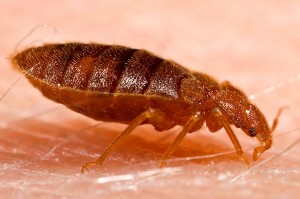Bed bugs are one of the most annoying insects anywhere. But you see how film makers make even the most annoying creatures loveable in movies.
Thus pictures of bed bugs in modern day magazines and textbooks are not as disgusting. Pictures of bed bugs you may see nowadays are just like pictures of cockroaches, ants and other insects. They are now ‘humanized or given the cordial and physical attributes of humans’.
Real picture
If you look at bed bugs under magnifying lens, you will discover that bed bugs are wingless insects. Bed bugs are not in any way different from other insects. They have waxy and protective skin covers.
Pictures of bed bugs show that bed bugs are so tiny. From atop, they appear like flatted creatures. No wonder, they can creed into and hide through even the smallest and tiniest crevices and holes in the floor and in walls.
Being so tiny, pictures of bed bugs are apparently taken using magnifying lenses or glasses. In real life, it follows that we can not see or look closely at bed bugs’ appearances because they are very small for our naked eyes.
If you have the incredible and dynamic eyesight of Spiderman, then you might probably enjoy and observe the physical attributes of bed bugs without lenses.
Where to see bed bugs
Another reason why you just can look at bed bugs’ pictures in textbooks and magazines is that bed bugs do not normally go out of their hiding places during daytime.
Night time is party time for these tiny creatures. It can be noted that during nigh time, bed bugs come out to suck blood. And we all admit that our eyes turn weaker and less clear during night times. Hence, we can hardly see bed bugs, especially during night time when they normally go out hunting and partying.
Bed bugs are almost always found in small holes and crevices in the floor or in walls.
Finding bed bugs also entails and requires a lot of luck on the part of the hunter or the person looking out for bed bugs. Why? Because adult or full-blown bed bugs can store up food in their stomachs for almost more than a year.
Sadly, now you know why pictures are more accessible than actual and live bed bugs even if you are sure your place or bed is a breeding ground.
The bed bugs’ eggs
Bed bugs are so small for our eyes to see them easily. Not surprisingly, the bed bug eggs are even tinier! Pictures of bed bugs’ eggs are almost always already miniscule, in real life, as well as in actual encounters, they are truly negligible!
They can be flown through the dust in the wind. That makes bed bugs’ eggs notorious. They can very easily multiply because of their size and light weight.
Closer look at bed bugs’ eggs’ images will show that they are almost like all other insects’ eggs, tiny, miniscule, yet equipped with structures that can make them independent. Thus, bed bugs’ eggs can hatch by themselves even without the presence of their moms.
It only takes ten days for bed bugs’ eggs to hatch. By that time, new bed bugs are borne to the world, and adding to the rapidly increasing bed bug population throughout the world.
Female bed bugs, as shown by some pictures retrievable through the Internet and through books, become like queen ants. They become enlarged before they lay eggs. Why? Did you know that female bed bugs can lay about 300 eggs in one pregnancy?
Eliminating bed bugs
Through bed bugs’ pictures and proper understanding, we can picture out and understand how pesticides work.
Through pictures, we can see that bed bugs have protective waxy coverings that make them similar with most insects. It is this physical attribute that makes bed bugs, and other insects with similar structures, endure annihilation and harsh environment changes.
A number of pesticides target these protective coverings. Insecticides mostly contain glass granules and powderized silicon that break into this protective covering.
Look closely at bed bugs’ pictures and you will see that after the waxy coverings, bed bugs’ vulnerable insides and bodies lie. This is where the pesticides attack these structure killing the bed bugs in minutes or hours.
Filed under: Bed Bugs
